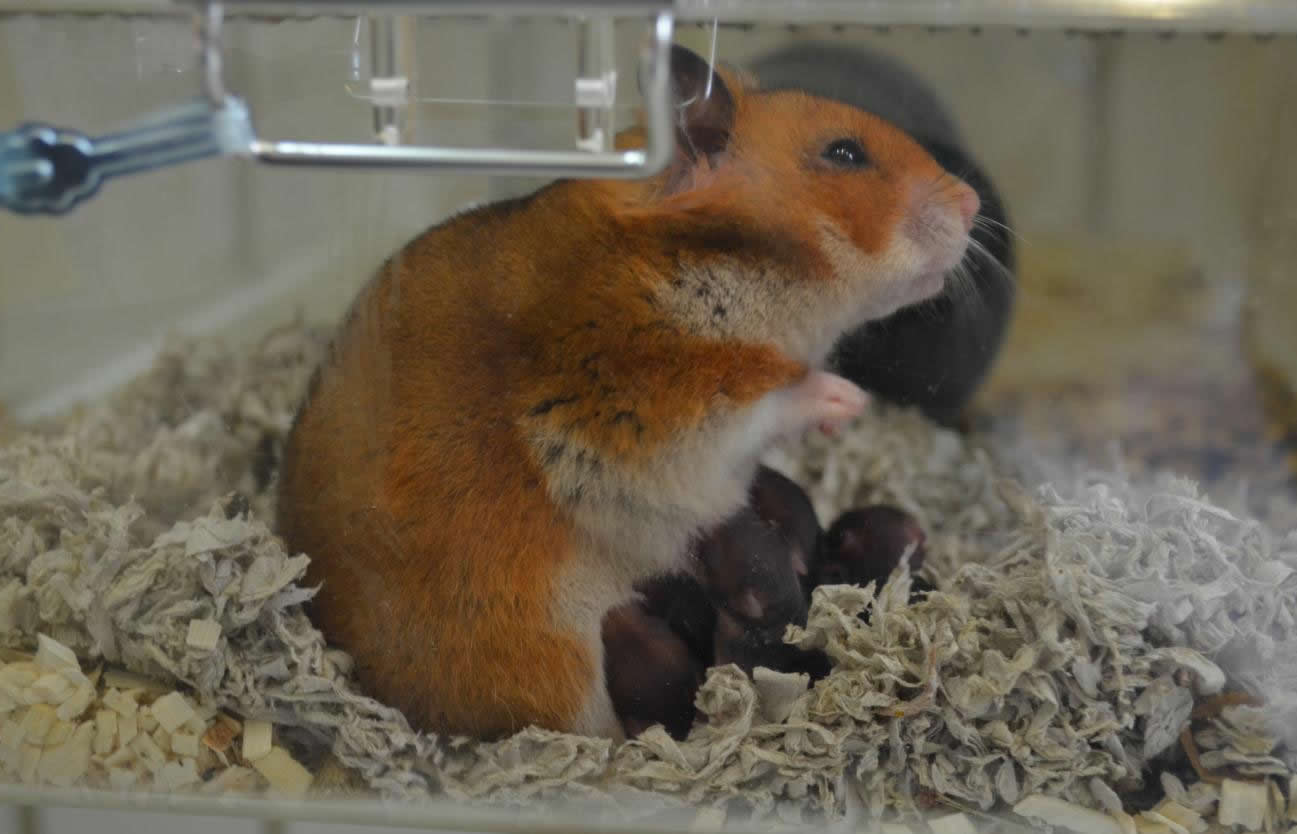|
|
|
Home | Pregnancy Timeline | News Alerts |News Archive Jul 23, 2015

Cooler temperatures induce hamsters to increase in milk production.
Image credit: Sarah A. Ohrnberger PhD — Research Institute of Wildlife Ecology,
University of Veterinary Medicine, Vienna, Austria |
|
|
|
|
|
How is temperature affecting mammal moms?
Temperature change affects reproduction in mammals as well as how they care for their young. With cooler temperatures, hamster moms increase their nursing output, but at warmer temperatures they decrease milk production. With climate change, researchers are hurrying to record how temperature flucturation impacts mammal moms and their babies.
When lactating female golden hamsters were exposed to three different ambient temperatures (5°C, 22°C, 28°C or 41°F, 71.6°F, 82.4°F) a significant difference was observed in their energy intake and milk output. The research results were published in the Journal of Experimental Biology.
"It is possible that climate change and global warming may make it harder for females to lactate or produce viable young."
Teresa Valencak PhD, team leader, Research Institute of Wildlife Ecology, University of Veterinary Medicine, Vienna, Austria.
Scientists found that energy spent by female hamsters at cooler outside temperature of 5°C [41°F] — was significantly higher than energy spent by females at warmer termperatures of 22°C [71.6°F]. In fact, hamster moms housed at the warmer temperature of 22°C [71.6°F], produced less milk than hamster moms housed at a cooler 5°C [41°F] temp.
On the other hand, pups housed at 5°C [41°F] showed much slower growth despite their higher milk intake from mom. Basically, they used up more energy just to keep their body warm at cooler temperatures, then they put into gaining weight. However, "At 28°C [82.4°F] a warm, comfortable ambient temperature, the exact opposite happens," observed Dr. Valencak. In warmer ambient temperature, mothers limited their milk production (perhaps to keep themselves from overheating) and their pups put on weight faster.
The mice mothers had access to cages at two ambient temperatures (10°C which is 50°F, and 21°C which is 69.8°F) joined by a tube. Food was only available to mom in the cold 10°C — 50°F cage. Pups were housed in the warmer cage. Control animals had access to the same arrangement of two cages joined by a tube, but both cages were maintained at 21°C — 69.8°F. The scientists thought that if milk production is limited by a moms' own body temp, it would help to provide her with access to a cooler environment cage where she could get rid of that body heat, eat more food and thus generate more milk to raise heavier litters. They measured her energy budgets and monitored her core body temperature and physical activity, while all litters were kept to around 12 pups so moms needed to produce the same amount of milk.
It turned out that females in the experimental group had higher energy intake, higher assimilated energy and provided their pups with more milk. This was consistent with researchers' expectations based on heat loss theory. Yet, despite the experimental mom's increased output, pup growth between the control group and the experimental group was about the same. These results emphasise the difficulty of guessing mom's milk production simply by observing how well her pups grew.
"Our first results show us that food intake was about 53% lower when there was an ambient temperature of 28°C [82.4°F] than at an ambient temperature of 22°C [71.6°F]. So it is feasible that females transfer less energy to their young under these conditions."
Teresa Valencak PhD
So, it may appear that female mammals constantly adjust their own body heat and lactation in response to ambient temperature, thus food availability. But also, shorten or extend their pups' infancy period of weight gain and growth — to match their own ability to lactate.
Abstract
The capacity of females to dissipate heat may constrain sustained energy intake during lactation. However, some previous experiments supporting this concept have confounded the impact of temperature on the mothers with the impact on the pups. We aimed to separate these effects in lactating laboratory mice (MF1 strain) by giving the mothers access to cages at two ambient temperatures (10 and 21°C) joined by a tube. Food was available only in the cold cage, but females could also choose go to this cage to cool down while their pups were housed in the warmer cage. Control animals had access to the same configuration of cages but with both maintained at 21°C. We hypothesised that if females were limited by heat dissipation, alleviating the heat load by providing a cool environment would allow them to dissipate more heat, take in more food, generate more milk and hence wean heavier litters. We measured maternal energy budgets and monitored time courses of core body temperature and physical activity. To minimise the variance in energy budgets, all litters were adjusted to 12 (±1) pups. Females in the experimental group had higher energy intake (F1,14=15.8, P=0.0014) and higher assimilated energy (F1,13=10.7, P=0.006), and provided their pups with more milk (F1,13=6.65, P=0.03), consistent with the heat dissipation limit theory. Yet, despite keeping demand constant, mean pup growth rates were similar (F1,13=0.06, P=0.8); thus, our data emphasise the difficulties of inferring milk production indirectly from pup growth
Return to top of page
|
